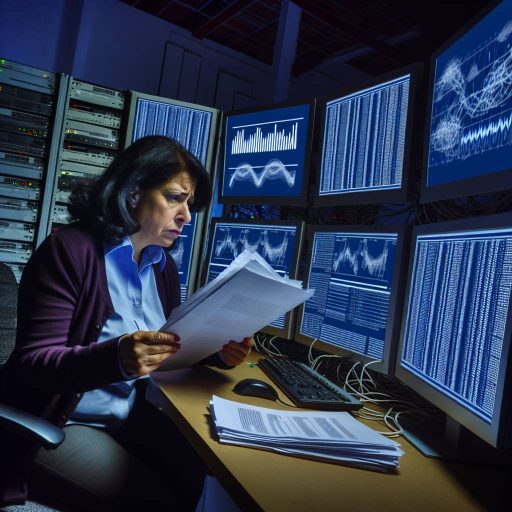Introduction:
Artificial Intelligence (AI) is revolutionizing cyber forensics analysis by automating processes and enhancing investigative capabilities.
The integration of AI algorithms in cyber forensics has streamlined the analysis of digital evidence.
AI has the ability to analyze huge volumes of data quickly, which significantly speeds up investigations.
By utilizing machine learning techniques, AI can uncover patterns and anomalies that might be missed by human investigators.
AI-powered tools can assist in the identification of cyber threats, helping organizations strengthen their security posture.
Furthermore, AI can enhance the accuracy of forensic analysis by reducing human error and bias.
The incorporation of AI in cyber forensics analysis is reshaping the way investigations are conducted.
AI-powered tools for data collection:
Artificial Intelligence (AI) has revolutionized the field of cyber forensics analysis by significantly enhancing data collection processes.
AI-powered tools play a crucial role in efficiently gathering digital evidence in cybercrime investigations.
Here are some key points to consider when discussing the use of AI in data collection for cyber forensics analysis:
- Efficiency: AI-powered tools automate the process of data collection, saving time and resources.
- Accuracy: AI algorithms are capable of accurately filtering through large volumes of data to identify relevant evidence.
- Speed: AI tools can analyze data at a much faster pace compared to manual methods, expediting the investigation process.
- Scalability: AI systems can handle massive amounts of data simultaneously, making them ideal for handling complex cybercrime cases.
One of the most widely used AI tools for data collection in cyber forensics analysis is Autopsy. Autopsy is an open-source digital forensics platform that utilizes AI algorithms to analyze disk images and other digital artifacts for potential evidence.
Another popular AI tool is X1 Social Discovery, which is specifically designed for collecting and analyzing social media data in cybercrime investigations. X1 Social Discovery uses AI-powered features to collect and preserve social media evidence in a forensically sound manner.
AI-powered tools like Autopsy and X1 Social Discovery have revolutionized data collection in cyber forensics analysis, providing investigators with advanced capabilities to retrieve and analyze digital evidence efficiently and accurately.
The Impact of AI on Cyber Forensics Analysis
When it comes to cyber forensics analysis, the impact of AI on streamlining data analysis cannot be overlooked.
AI algorithms have revolutionized the way large amounts of data are processed and analyzed in cyber forensics investigations.
Streamlining Data Analysis with AI
AI algorithms have the capability to analyze vast quantities of data quickly and efficiently.
They use machine learning techniques to identify patterns, anomalies, and potential threats in the data.
This speed and accuracy are crucial in cyber forensics, where time is of the essence in uncovering and mitigating security breaches.
Importance of Streamlining Data Analysis in Cyber Forensics
- Timely Response: With the help of AI, cyber forensics teams can swiftly respond to security incidents and prevent further damage.
- Efficiency: AI streamlines the data analysis process, allowing investigators to focus on interpreting results and making informed decisions.
- Scalability: As data volumes increase, AI technologies can scale effortlessly to handle the growing demands of cyber forensics investigations.
Examples of AI Technologies in Cyber Forensics Investigations
- Machine Learning: AI algorithms can analyze network traffic patterns to detect abnormal behavior indicative of a cyber attack.
- Natural Language Processing: AI tools can sift through massive amounts of text data to identify relevant information in forensic investigations.
- Pattern Recognition: AI can recognize suspicious patterns in system logs, making it easier to pinpoint security breaches and unauthorized access.
AI has significantly enhanced the capabilities of cyber forensics analysis by streamlining data analysis processes.
As AI technologies continue to evolve, we can expect even greater efficiency and accuracy in detecting and responding to cyber threats.
Transform Your Career Today
Unlock a personalized career strategy that drives real results. Get tailored advice and a roadmap designed just for you.
Start NowUncover the Details: Essential Tools and Technologies for Big Data Engineers
Enhancing Threat Detection and Prevention
AI plays a crucial role in improving threat detection and prevention in cyber forensics analysis.
By harnessing the power of artificial intelligence, organizations can stay ahead of cyber threats and protect their data effectively.
Here are some ways AI can help detect and prevent cyber threats:
- Machine learning algorithms: AI algorithms can analyze large volumes of data to identify patterns and anomalies that indicate potential security breaches.
- Behavioral analysis: AI can track user behavior and detect any deviations from the norm, flagging suspicious activities that may signal a cyber attack.
- Predictive analytics: AI can use historical data to predict future threats and provide proactive measures to mitigate risks before they escalate.
The benefits of using AI for threat detection in cyber forensics are manifold:
- Rapid threat identification: AI can quickly identify and respond to security incidents, reducing the time it takes to detect and contain threats.
- Improved accuracy: AI algorithms can analyze data with precision and consistency, reducing false positives and negatives in threat detection.
- Continuous monitoring: AI systems can work around the clock to monitor networks and systems for any signs of suspicious behavior, ensuring constant vigilance against threats.
Several AI technologies are used for threat detection in cyber forensics analysis:
- Deep learning: Deep neural networks can process vast amounts of data to detect complex patterns and anomalies in network traffic.
- Natural language processing (NLP): NLP algorithms can analyze text data to identify threats hidden in communication logs or messages.
- Self-learning systems: AI systems that can adapt and learn from new data to improve threat detection capabilities over time.
Discover More: Future Trends in IT Security Management
Improving accuracy in evidence identification:
Artificial Intelligence (AI) can enhance accuracy by analyzing large amounts of data quickly.
AI algorithms can spot patterns and anomalies that might be missed by human investigators.
By using AI, investigators can focus on more complex tasks, leaving repetitive ones to AI.
AI can reduce human error in evidence identification by providing consistent results.
AI technologies play a crucial role in evidence identification in cyber forensics analysis:
- Machine Learning algorithms can classify data, making it easier to find evidence.
- Natural Language Processing (NLP) helps in analyzing text data for relevant information.
- Deep Learning models can detect objects, faces, or text within images or videos.
- AI-powered tools like forensic analysis software can automate the process of evidence identification.
See Related Content: The Role of a Systems Analyst in IT Project Management

Challenges Faced in Implementing AI in Cyber Forensics Analysis
Lack of skilled professionals trained in both AI and cyber forensics.
Difficulty in interpreting results generated by AI algorithms accurately.
Issues with integrating AI tools with existing cyber forensics systems.
Concerns about the reliability and accuracy of AI-generated evidence.
Complexity of cyber attacks requiring advanced AI models for detection.
Limitations of AI Technologies in the Field of Cyber Forensics
AI algorithms may not always be able to keep up with rapidly evolving cyber threats.
Certain types of cyber attacks may be too sophisticated for current AI capabilities to detect.
Transform Your Career Today
Unlock a personalized career strategy that drives real results. Get tailored advice and a roadmap designed just for you.
Start NowPrivacy and ethical concerns related to the use of AI in cyber forensics investigations.
Potential biases in AI algorithms that could affect the outcome of forensic analysis.
Difficulty in explaining AI-generated results to non-technical stakeholders in legal settings.
Recommendations for Overcoming Challenges and Limitations
Invest in training programs to upskill existing cyber forensics professionals in AI technologies.
Develop AI systems that provide transparency in their decision-making processes for better interpretation.
Collaborate with AI experts to customize algorithms for specific cyber forensics use cases.
Implement strict guidelines and regulations to address privacy and ethical concerns related to AI usage.
Enhance communication between technical and non-technical stakeholders to improve understanding of AI-generated results.
Uncover the Details: Effective Communication Tips for Systems Administrators
Ethical considerations in AI-powered cyber forensics analysis:
When it comes to utilizing artificial intelligence in cyber forensics investigations, there are several ethical considerations that need to be taken into account.
These considerations play a crucial role in ensuring that the use of AI in cyber forensics remains ethical and follows best practices.
Discuss the ethical implications of using AI in cyber forensics investigations:
- AI has the potential to enhance the efficiency and accuracy of cyber forensic analysis.
- However, there are concerns about the privacy of individuals whose data is being analyzed.
- There is also the risk of bias in AI algorithms, which can lead to misleading conclusions.
- Ethical questions arise regarding the transparency of AI-powered forensic processes.
- Furthermore, the question of accountability in case of errors made by AI systems is critical.
Explore issues such as privacy, bias, and transparency in AI-powered cyber forensics analysis:
- Privacy concerns revolve around the potential misuse of personal or sensitive data during investigations.
- Bias in AI algorithms can result from skewed training data or inherent algorithmic biases.
- Transparency is essential to understand how AI algorithms arrive at their conclusions or decisions.
- Lack of transparency can raise doubts about the reliability and validity of forensic findings.
Provide recommendations for ensuring ethical practices in the use of AI in cyber forensics:
- Adopting clear and comprehensive ethical guidelines for using AI in cyber forensics analysis.
- Regular auditing and monitoring of AI algorithms to identify and mitigate biases.
- Ensuring transparency by documenting and explaining the decision-making process of AI systems.
- Implementing secure data handling practices to safeguard the privacy of individuals involved.
- Establishing mechanisms for holding accountable those responsible for errors or misuse of AI in cyber forensics.
By addressing these ethical considerations and implementing the recommended practices, the integration of AI in cyber forensics can be done responsibly and ethically, ensuring that the rights and privacy of individuals are protected throughout the investigative process.
Future Advancements in AI and Cyber Forensics
AI has revolutionized cyber forensics analysis by automating tasks.
It analyzes large datasets efficiently and detects anomalies accurately.
The potential future advancements in AI technologies for cyber forensics include improved machine learning algorithms.
Advanced behavioral analysis will enhance our understanding of threats.
Real-time threat detection will provide proactive defenses against cyber attacks.
Encouraging further research and development in AI and cyber forensics analysis is essential.
This initiative will help us stay ahead of cybercriminals and strengthen cybersecurity defenses.
Additional Resources
Artificial Intelligence in Crime Detection: How It’s Useful | American …
Transform Your Career Today
Unlock a personalized career strategy that drives real results. Get tailored advice and a roadmap designed just for you.
Start Now



